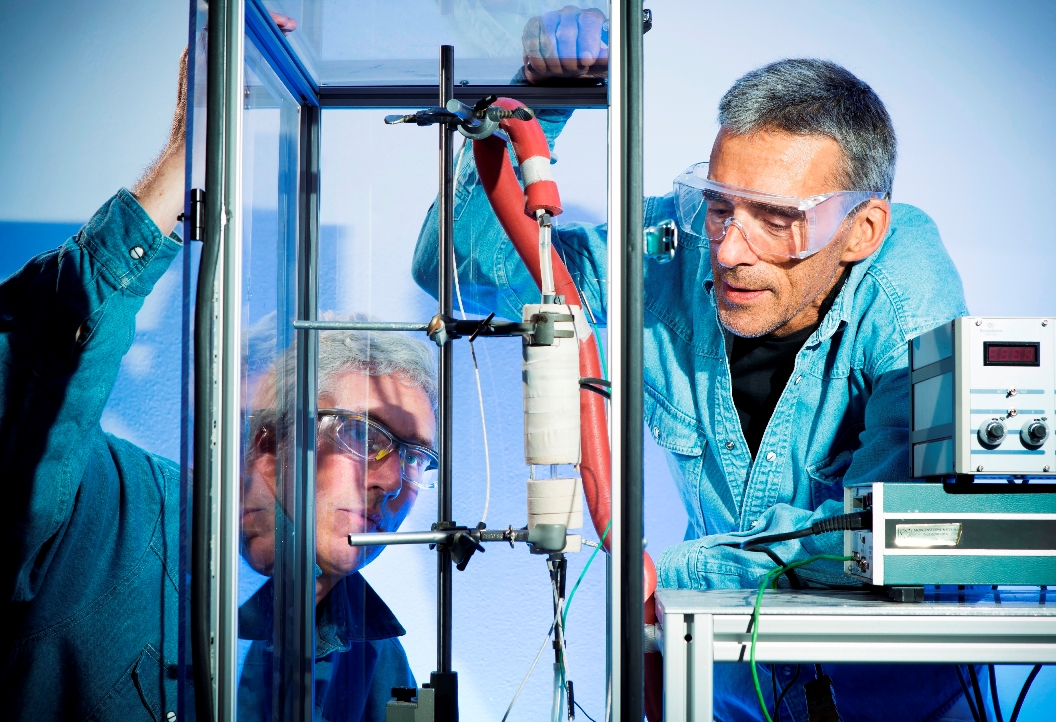A reactor’s secret life
What happens inside chemical reactors and furnaces has always been a well-kept secret. Until now.
Astronomers use specialist technology to look out into the infinite reaches of the universe when they study the stars and planets. Norwegian researchers are a little more down to earth. They are now using the same kind of technology to reveal what happens inside reactors. The technology is known as infra-red emission spectroscopy.
FACTS: What is a reactor?
A reactor is a unit in process equipment where one or more chemical reactions take place. Conditions in the reactor influence the quality of the product. This means that knowledge about what is happening inside a reactor is important if we are to achieve the best possible product at the lowest possible production cost.
Experts have always known what goes into a reactor – and what comes out, but it has proved more difficult to discover what is really happening from a purely chemical perspective. This might not sound quite so strange when you consider that a reactor may be operating at several hundred degrees Celsius, while temperatures inside a furnace may be well over 1,400 degrees Celsius. This is enough to destroy most kinds of measuring equipment.
Portable equipment
However, infra-red emission spectroscopy allows researchers to take readings of the infra-red heat radiated inside the reactor, and thus identify the gases formed and temperatures involved.
This is possible because everything at a temperature above absolute zero emits infra-red radiation, but the intensity of the radiation increases and the wavelength decreases markedly as temperature increases.
“In simple terms, what we do is take readings of the wavelength and intensity of the infra-red waves emitted by the hot gases. These data tell us how the chemical processes are working, and can be used, for example, to improve existing processes and develop new catalysers”, says Thorshaug.
Extreme temperatures
Although the equipment is advanced, it doesn’t look particularly special. To you and me it’s just a little black box connected to a laptop.
“Because it’s not big and heavy, we can carry it to a reactor, whenever and wherever we want to take measurements. In an industrial context, this is a huge advantage in places like factories and smelting plants”, explains Thorshaug.
FACTS:
When developing, improving and monitoring industrial chemical processes, it is important to have the best possible understanding of the chemical reactions taking place. Infra-red spectroscopy is a well-known analytical technique, but when the temperatures being measured are very high, analysis is complicated because it is often difficult to maintain a stable radiation source with a free absorption path throughout the process.
This problem can be resolved by studying only emitted energy (energy that radiates from the process). The technique is known as infra-red emission spectroscopy (IRES) and has been used for applications such as the study of molecules on earth and in outer space.
Based on this principle, researchers at SINTEF have been working with organisations such as inGAP, a Norwegian centre for research-based innovation (www.mn.uio.no/ingap), Dynea, the Norwegian Ferroalloy Producers Research Association (FFF), Elkem, and other Norwegian industrial companies, to develop a method for analysing hot gases. The method can be used to monitor and measure what happens in different types of industrial reactors, and can also be used to analyse catalytic processes.
However, the device is much more advanced than it looks. The computer programs used to interpret the data have been developed by researchers at SINTEF ICT. Some equipment components have been specially constructed of sapphire glass, which can tolerate extremely high temperatures.
“We had this specially made in Switzerland, after spending a lot of time finding a company that could manufacture the equipment in sapphire glass according to our specifications”, explains Thorshaug.
The equipment can be used to study hydrocarbons, water, carbon monoxide and carbon dioxide at temperatures in the region of 500–700⁰C.
“The method gives us a unique opportunity to see what happens, and when it happens – in so-called real time. We can also take temperature readings using this method. This is important because the temperature tells us whether the process is working as it should”.
In the crucible
To date, SINTEF has analysed exhaust gases from furnaces at the Thamshamn smelting plant. Researchers have also been using the method to measure the temperatures of such gases and to find out how much solid material (silica) passes out into the atmosphere with the gas.
The principle has proved to be ideal for measuring and analysing emissions from factory chimneys.
“We can now identify the polluting substances the smoke contains, and determine whether there are compounds there which might be better exploited”, says Thorshaug.
In the laboratory, the method is ideal for studying miniature versions of industrial reactors, and this is important in the work to develop new and improved factory processes.
Many uses
However, according to Thorshaug, the potential applications of this type of spectroscopy are far more extensive.
“In the future, we see this technology being used to check, control and monitor chemical processes. We have also developed a laboratory model that uses the same technology to analyse reactions linked to a variety of catalytic processes”.





